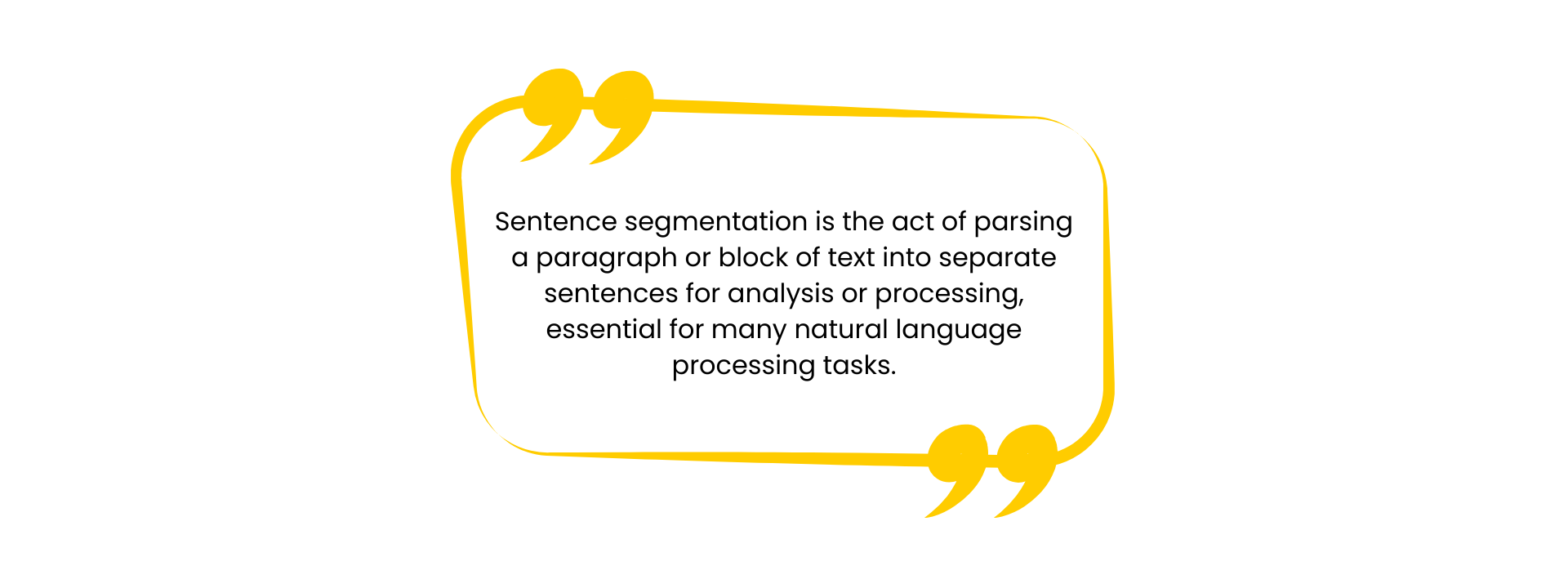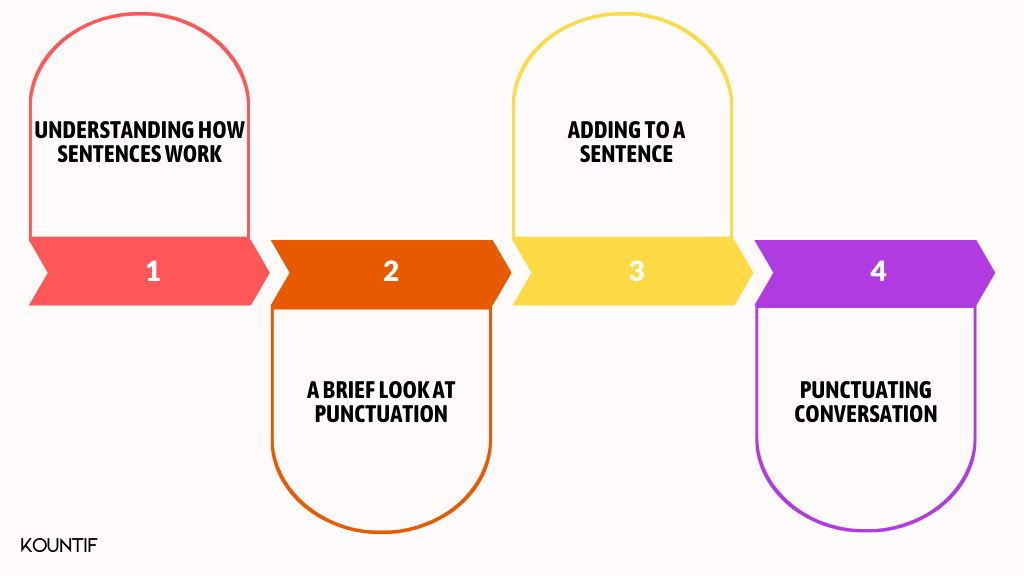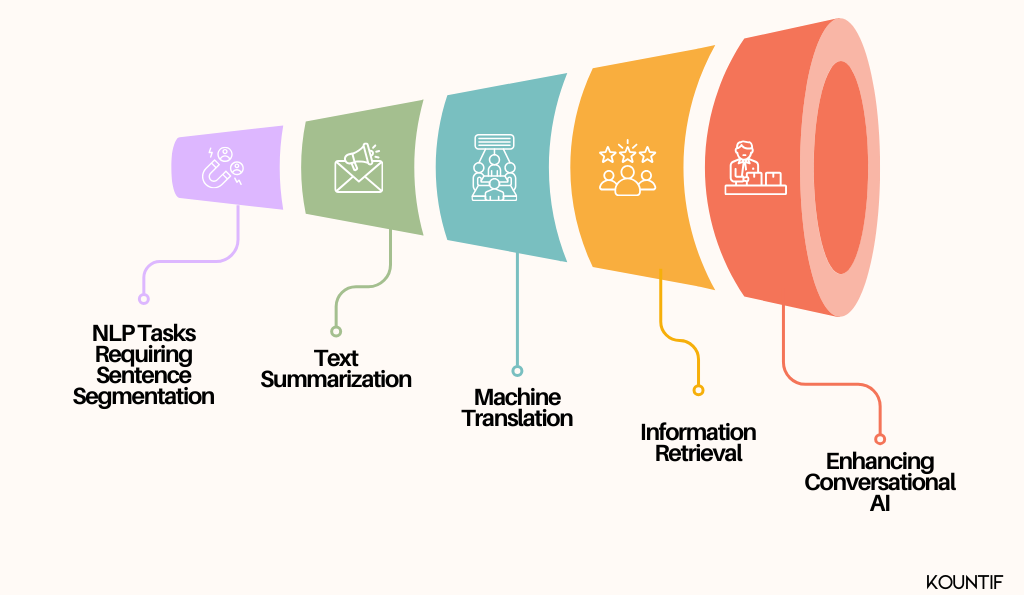![Write Letters for Money [top 13 ways]](https://kountif.com/wp-content/uploads/2024/08/Write-Letters-for-Money-top-13-ways-.jpg)
Table of Contents
ToggleWhat is Sentence Segmentation
We will go into great detail about the art and science of sentence division. Whether you’re a content marketer writing compelling content or a teacher changing young minds, understanding sentence division is essential. This thorough guide will examine why this part of grammar is necessary, how to teach it, fun games, and examples of how it can be used in real life.
In the vast ocean of language, words are the building blocks. Skillfully breaking them up makes them easier to read and understand. In the digital age, knowing how sentence division works is essential for many things, not just conversation. We hope this blog post gives you information about Sentence Segmentation.
Understanding Sentences
Understanding a phrase before getting too involved in the segmentation debate is essential. A phrase is a collection of words conveying a whole concept or idea. This construction has a verb, a subject, and frequently an object. An independent phrase makes a sentence complete because it stands on its own. Learn about Parts of Speech.
Why It is Important?

Sentence segmentation, breaking text into words that make sense, makes it much easier to read. It makes the information move more naturally and keeps you from using run-on sentences. The way readers stop, consider, or respond to the material they read is determined by effective segmentation. Segmented phrases are essential in improving readability and user experience in the digital world.
Teaching Strategies
Teaching sentence segmentation may be challenging for teachers. In addition to knowing how words are put together, you must use marking rules to show where each phrase begins and ends.
Step-by-Step Guide to Teaching Sentences Segmentation

- Understanding How Sentences Work: Learn how to make simple lines; this is the first thing you do when learning a language. This means understanding what a full thought is and how a sentence’s subject, verb, and object work together effectively. Focusing on these basic things will help you communicate ideas clearly and effectively.
- A Brief Look at Punctuation:Using punctuation like question marks, exclamation points, and spaces is essential. Each mark makes things clearer and more effective. Statements end with a period, queries with a question mark, and exclamation points that show joy or stress. If you learn these marks, you can improve your writing and clarify your point.
- Adding to a sentence: Once you understand sentences and punctuation, it’s time to add more complexity. By teaching students how to use conjunctions like “and” or “but,” they can learn how to combine two smaller sentences into one longer sentence without losing clarity. This will help them improve their writing skills and make their sentences more interesting.
- Punctuating Conversation: Dialogue is an important part of stories because it moves the plot forward, shows us more about the characters, and changes the world. It’s essential to teach kids how to structure conversation properly. It would help if you taught them to put commas between stops and speaking and to capitalize the first letter of spoken statements. The right style keeps things clear and makes them easier to read. By getting good at this skill, students can write clearly and have interesting conversations, improving their writing.
End-of-Sentence Punctuation: Sentence Types
Punctuation marks are essential, not just decorative. They convey tones and nuances, affecting sentence interpretation. Beyond periods and commas, semicolons, exclamation points, and question marks enhance meaning and clarity. Effective use of these symbols can make writing more engaging and more straightforward for readers.

Periods (.) – The Stop Sign of Sentences
To effectively communicate that a sentence has reached its conclusion, it is standard practice to end it with a period. This punctuation mark serves as a clear indicator for the reader to halt momentarily, allowing them to absorb and fully comprehend the information presented before moving on to the following sentence.
Example: James is a good student.
The Question Mark (?) – The Curious Wonders
A question mark is a punctuation mark that indicates a question. It prompts readers to think about the content critically and often invites a response, fostering two-way communication. This simple but profound mark is essential in written language, signaling queries and engaging the reader’s curiosity.
Example: What is the best way to learn sentence segmentation?
The Exclamation Marks (!) – The Excitement Booster
An exclamation mark, like a period, ends a sentence but adds a strong emotional impact. It’s an assertive stop, demanding attention and adding urgency or intense emotion to the statement. It can express excitement, surprise, anger, or a command, transforming a simple sentence into a compelling declaration.
Example: Oh, I won the race!
Applications of Sentence Segmentations
Sentence segmentation may seem basic, but its importance must be considered in the digital age. Effective use of sentence segmentation has many applications and we will discuss it below.

NLP Tasks Requiring Sentence Segmentations
Part-of-speech tagging, named entity recognition, and text tokenization are crucial for effective natural language processing (NLP) on structured text. Proper segmentation is essential; NLP models can process words efficiently. Better segmentation helps models understand context and meaning, improving their ability to identify nouns, verbs, and entities like people or places. Streamlining these tasks enhances NLP performance, enabling more advanced text interactions.
Example: A sentence like “The cat sat on the mat” can be recognized and understood more accurately if correctly segmented into individual words.
Text Summarization
Machine-learning models greatly benefit from text summarization, which helps consolidate information from different sources. This technique is crucial in AI development, turning long narratives into concise summaries. It streamlines data analysis, making complex information more accessible for machines and humans. This method improves the readability of lengthy documents and highlights critical information.
Example: A news article is summarized into a few sentences, allowing readers to understand the main points quickly.
Machine Translation
To boost machine translation accuracy, divide the input text into sentences. This approach lets each sentence be translated separately for better nuance and context capture. Once translated, sentences are reassembled into a coherent thought in the new language. This method improves translation clarity and fidelity, providing a more accurate representation of the original message.
Example: A sentence like “I love to travel and experience new cultures.” would be translated more accurately if segmented into two sentences: “I love to travel.” and “I also enjoy experiencing new cultures.”
Information Retrieval
Sentence segmentation is crucial for search engines and knowledge management systems to store and retrieve information effectively. These systems better understand the content by breaking text into clear sentences, enabling more detailed analysis. This helps identify subtle differences and nuances, leading to more accurate and relevant search results and enhancing the efficiency and reliability of the system.
Example: When searching for a particular topic, the search engine uses sentence segmentation to understand the query better and provide more precise results.
Enhancing Conversational AI
Sentence segmentation is crucial for improving conversational AI, like chatbots and virtual assistants. It involves identifying sentence boundaries, a critical step in allowing AI to understand human queries more effectively. This technique helps chatbots and virtual assistants give more accurate and relevant responses, improving user experience. It’s essential for enabling AI to handle a wide range of queries precisely, from simple questions to complex interactions.
Example: A chatbot uses sentence segmentation to understand user queries and provide relevant responses, making the conversation more fluid and effective.
Quick Overview of Sentence Segmentation
| Category | Benefits | Applications |
|---|---|---|
| Readability | Improved comprehension, easier to read | Text summarization, machine translation |
| Writing Skills | Enhanced writing quality, clear communication | Writing assistance, language learning |
| Natural Language Processing (NLP) | Better context understanding, accurate analysis | Sentiment analysis, entity recognition |
| Machine Translation | More accurate translations, reduced errors | Cross-language communication, globalization |
| Conversational AI | Improved chatbot responses, more effective conversations | Customer service, virtual assistants |
| Education | Enhanced literacy, better writing skills | Language teaching, writing instruction |
Sentence Segmentation Statistics
| Category | Statistic | Benefit |
|---|---|---|
| Students needing help | 82% | Improved understanding of word breakdown and sentence structure |
| Reading comprehension | 40% | Better understanding of read material through regular sentence division practice |
| NLP accuracy | 30% | Increased accuracy in NLP applications with advanced sentence segmentation techniques |
| Machine translation error rate | 25% | Reduced errors in machine translation, making translations more reliable and understandable |
| Educator belief | 70% | Critical importance of sentence segmentation in enhancing literacy among students, especially in early education |
| Writing error reduction | 50% | Significant reduction in writing errors through sentence separation exercises in classrooms |
Conclusion
Sentence segmentation is an integral part of language processing that improves writing, reading, and speaking. People can improve their writing, make their ideas more transparent, straightforward, and exciting, and improve reading by correctly dividing lines. There are a lot of different uses for sentence segmentation, from natural language processing and machine translation to text summaries and AI that can have conversations. People can make their ideas clearer and more potent by using sentence-division methods in their writing and speaking.
FAQs
Why is it important to divide sentences?
The process of breaking text into separate lines is called sentence segmentation. This is necessary to make text easier to read, improve the quality of writing, and improve conversation in general.
How does breaking up sentences help you get better at writing?
By showing people how to properly break up sentences, use punctuation marks, and get their points across more quickly, sentence segmentation can help them improve their writing.
What are some ways that sentence division can be used?
Sentence segmentation is used in natural language processing, machine translation, text summaries, and AI that can have conversations.
How does breaking up a line make it easier to understand and read?
Using sentence separation can help readers understand and remember what they’re reading by breaking up long pieces of text into smaller, easier-to-handle pieces.



![How to Write Acknowledgments for a Book [Complete Guide]](https://kountif.com/wp-content/uploads/2024/08/How-to-Write-Acknowledgments-for-a-Book-1-1.png)